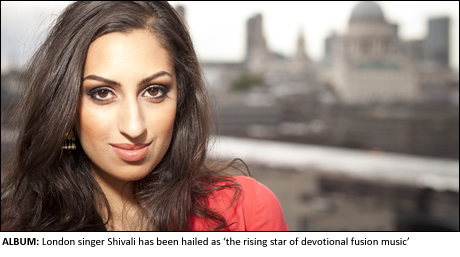 Hindus around the world celebrated Maha Shivaratri or “the great night of Shiva,” this week. Not only is this festival observed on the 14th night of the new moon during the Hindu lunar month of Phalguna, but there are several myths associated with the holiday. One such legend says that Lord Shiva married his spouse, Parvati on this day. Because of this, some unmarried Hindu women believe this day is ideal to pray for a husband like Lord Shiva, while many married women pray for the well-being of their spouse and family.
Hindus around the world celebrated Maha Shivaratri or “the great night of Shiva,” this week. Not only is this festival observed on the 14th night of the new moon during the Hindu lunar month of Phalguna, but there are several myths associated with the holiday. One such legend says that Lord Shiva married his spouse, Parvati on this day. Because of this, some unmarried Hindu women believe this day is ideal to pray for a husband like Lord Shiva, while many married women pray for the well-being of their spouse and family.
One part of the holiday I enjoy is the recitation of the Mahamrityunjaya Mantra, which is repeated 108 times after a day-long fast. My favorite version of the mantra with the Sanskrit lyrics and translation is below:
Om Tryambakam Yajamahe Sugandhim Pushtivardhanam
Urvarukamiva Bandhanan Mrityor Mukshiya Maamritat
Translation: We meditate on the Three-eyed reality which permeates and nourishes all like a fragrance. May we be liberated from death for the sake of immortality, even as a cucumber is severed from bondage to the creeper.
Every time I hear this incantation, I’m not only reminded of how it’s used for healing, restoring health, courage and peace when overcome with fear, sickness or even death, but also of the prime place devotional songs have in a Hindu household.
Growing up, I saw hymn books continuously shuffled among crowds in mandirs, and many of my first-generation peers were trained in music schools all over New York City to play the harmonium, sitar, dholak, tabla, and sing Hindi bhajans, even though they often had no prior knowledge of the language.
While I’m not a musical prodigy, I’ve always been fond of the bhajan genre. I’ve also noticed throughout the years that these devotional songs historically been very classically oriented and, perhaps because of that, younger South Asian Americans, who may prefer the pop hits of Bollywood, often overlook them. I believe this is because many recordings of bhajans are too old-fashioned and nondescript, while, paradoxically, songs like “Tumhi Ho Bandhu” from Cocktail or “Ragupati Raghav” from Krrish 3 come across as too filmy.
Whatever the case, many current artists have begun to incorporate bhajans into their work, understanding that the genre must not only evolve and stand on an international scale with a certain hybridity of western instruments and eastern rhythm, but also have a melodious exchange that holds the same message between the older and younger generations. It’s a market gap craving to be filled.
Take Shivali Bhammer, for example, a UK-based artist signed with Sony Music India, who released devotional albums The Bhajan Project and Urban Temple over the past two years — both of which contain tracks infused with hip-hop and R&B beats. Her soulful and happy voice is beyond contagious when she sings the name of the Lord; you’re bound to be cleansed!
One of my favorites on the Urban Temple album is “Jai Jai Radha Raman” and not only because it’s a fast tune. The musical palate is enhanced with percussion, guitar and flute all so delicately and flawlessly flowing together that it serves as a peaceful reminder that devotion is prevalent in every action that God sees. Listen below:
http://www.youtube.com/watch?v=vb0dmcCoTO0
Another UK-based artist, Steven Kapur aka Apache Indian, added his own spice to the bhajan mix, releasing an album via Universal Music India titled Home Run, which featured artists like Malkit Singh, A. R. Rahman, Asha Bhosle, Shaggy and others, and was infused with heavily eclectic tracks. One selection that specifically stood out to me was the electrifying head-bopping yet revered reggae backdrop to the ancient chant titled “Om Namah Shivaya.” I love the sporadic addition of the mellow tune the flute brings throughout. Check it out below:
There’s something universal about the idea of spreading religion through songs when you don’t even speak the language you’re singing. That’s what I think about when I hear Priyanka Singuianist’s comforting voice in her version of “Jag Mein Sundar Hain” supported by the moving touch of modern instruments such as guitar and keyboards. She’s a rising star in her own right striving to be a music director and this rock-bhajan mix is one of the best forms of devotion for generations to come. Listen below:
These examples of Hindu devotional music remind us that the way we express our worship doesn’t have to be traditional; life’s much more diverse than that…it’s fluid and pulls you in different directions just like music. So just as Hindus celebrated Maha Shivaratri this year, think about how far and great culture as an entity has come. If you believe in a higher being, you have the ability to offer gratitude through an array of sounds, words, and actions, so why not offer versatility at its best?
Ashley Kooblall is a NYC-based online writer/editor whose work has been featured in YourTango, Women’s Health, and DISFunkshion Magazine. In her spare time she can be found in the nearest Barnes & Noble scoping out the latest books, preferably South Asian historical fiction. Follow her on Twitter @akooblall.













